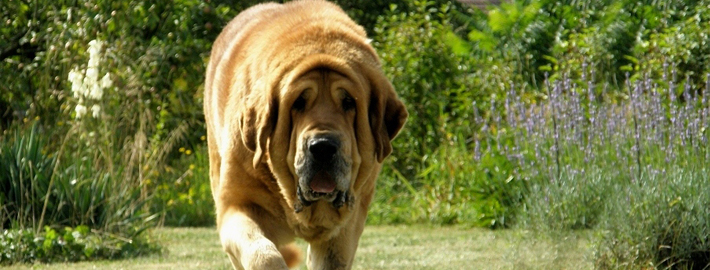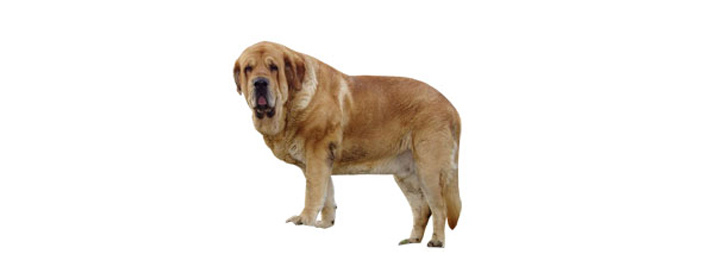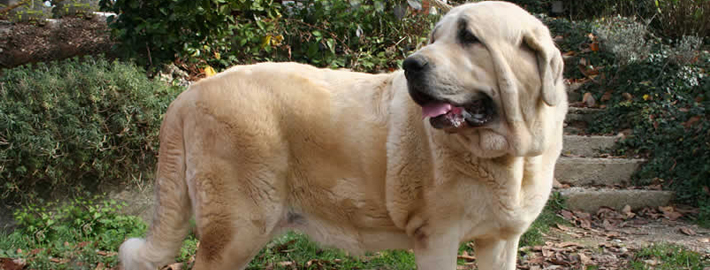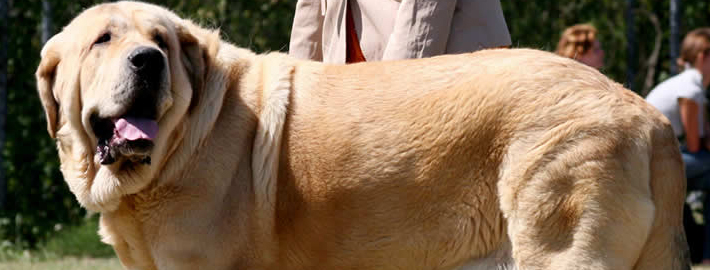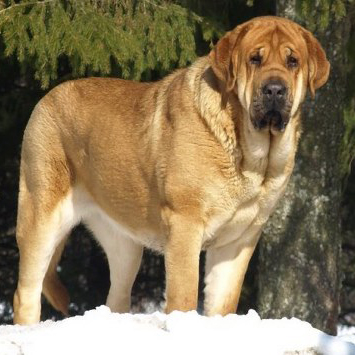What makes the Spanish Mastiff Unique?
The Spanish Mastiff is best known for its size, with some weighing well over 200 pounds. It is the largest dog breed of Spain and is also known as Mastín Espanol, Mastín de Espana, Mastin de la Mancha, Mastin de Extremadura and Mastin de Leon. Its body is a stocky, robust, rustic-looking dog. The body should be rectangular, well-muscled and with strong bone. It has a massive, well-proportioned head with a deep muzzle, strong jaws, full lips and a characteristic dewlap on the neck, showing clearly his mastiff type.
Breed Groups
Page Contents
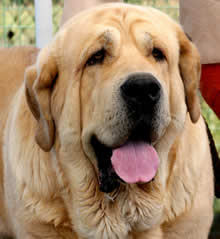
SnapShot
| Size: | Males – 72 to 88 cm (28 to 35 inches) Females – 72 to 88 cm (28 to 35 inches) |
| Weight: | Males – 90 to 100 kg (185 to 200 pounds) Females – 52 to 77 kg (145 to 170 pounds) |
| Origin: | Spain, Europe, India |
| Life Span: | 10 – 14 Years |
| Colour: | Plain yellow, Red, Black, Wolf-grey and Red-brown |
| Litter Size: | up to 10 puppies |
Is the Spanish Mastiff Right For You?
The Spanish Mastiff is a stocky, robust, rustic-looking dog. These dogs are dignified, noble and not overly demonstrative. They are loyal and really do love you, and will sacrifice his/her own life to protect you, your family or your livestock, when necessary. They like to be close to their owners. Although the Mastin may appear lazy and even slothful at times, it is always watchful and alert to everything that goes on around it.
Because of this dog’s sheer size, the Spanish Mastiff is not recommended for apartment life unless you plan to be very consistent with your pack walks, putting the dog in a rest mode for most of the day. These dogs are somewhat inactive indoors and should at least have a large yard. This dog’s thick coat protects it from cold and wet so it can live outdoors. However, they are easy to housebreak and would love to live indoors close to their family. Spanish Mastiff can handle both extreme heat and cold with no problems. However, it should have access to shade and water during the summer. The Spanish Mastiff is a double-coated breed, they shed heavily twice a year and “blow” their coats in the Spring; they do shed to an extent year around. If kept as indoor dogs, will shed heavily year around, making the Mastin unsuitable for a neat and tidy home.
In 5 Words
- Noble
- Self-assured
- Protective
- Affectionate
- Intelligent
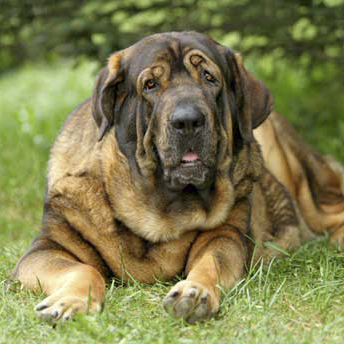
Characteristics
Learn About the Spanish Mastiff
Description
General Description
The Spanish Mastiff is the largest dog breed of Spain and is also known as Mastín Espanol, Mastín de Espana, Mastin de la Mancha, Mastin de Extremadura and Mastin de Leon. It is believed to be the Largest Guardien Dog (LGD) breed in the world. This mountain type dog was developed from ancient molossus dogs that accompanied Alexender the Great throughout Europe. Originated from Estramadura region some 2000 years B.C, this ferocious live stock guardian was once used to hunt wild boar and also as war dog but its prime responsibility always remains guarding the flock from wolves, bears and other predators. The Spanish Mastiff is a powerful dog and is called Masten de Leon as this mastiff among dog breeds is what the Lion is among ferel animals. It makes the great defender of the sheep and formidable and worst enemy of wolves and other predators. There are two types of Spanish Mastiff – the Mastin Pesado and Mastin Lagero. The Mastin Pesado is the heavier type Spanish Mountain with a more impressive appearance and it is found in mountain areas of Spain while the Mastin Lagero is the lighter and more athletic, agile and faster breed that is found in Andalusia, Meseta and in other regions south of Spain. Generally, the Spanish Mastiff stands atleast 30 inches and weighs about 140 to 175 lbs. This well balanced and well boned breed comes with a big, massive and pyramid shaped head with typical mastiff loose fold skin, broad and strong skull and rectangular muzzle. Wet, big and wide nose is black in colour. Hazel colour, almond shaped eyes have soft, noble and intelligent expression which can change to stern gaze in front of strangers. Triangular shaped, flat and hanging ears are attached above eye line. The neck is broad and solid. Massive body is rectangular in shape and comes with straight topline, powerful and muscled back, long, broad and powerful loin and deep, broad and well muscled chest with rounded ribs. Medium length, dense coat is equally distributed all over the body and is preferred in yellow, fawn, red, black and wolf colour. This breed is NOT recognized by AKC however it is recognized by FCI.
Size
The height of these dogs is about 28 – 35 inches (72 – 88 cm) while the weight: Males 185 – 220 pounds (90 – 100 kg) Females 145 – 170 pounds (52 – 77 kg).
Some of the larger males can weigh as much as 265 pounds (120 kg)
The Spanish Mastiff is the largest of all the Spanish native dog breeds and is the heaviest of the LGDs.
Coat
The Spanish Mastiff has medium length, thick and smooth coat with a dense undercoat. The coat is shorter on legs and longer, silkier on tail.
Short History of the Spanish Mastiff
The Spanish Mastiff is a very old breed, with records being traced to over 2,000 years ago. Mentions of the Mastiff in writing first appeared from the Iberian Peninsula, where the breed was most likely introduced by the Greeks and Phoenicians before the Roman invasion.
This large breed was used in Europe as a herding dog for transporting and protecting the Merino livestock. The Spanish Mastiff’s mostly white color was helpful in differentiating the large dog from the wolves they guarded the sheep from. Records show that in 1526 about 3.5 million Merino sheep migrated with at least one Mastiff for every 100 sheep. It is also believed that the Spaniards used this breed in battles against the native peoples they conquered.
Europeans admired the Spanish Mastiff as a breed that is resistant towards climate changes and harsh conditions, and as a very independent dog with strong defense instincts.
Temperament
In character and function, the Spanish Mastin is a classic LGD (Livestock Guardian Dog) and is very similar in many ways to his cousin, the Anatolian Shepherd Dog. These dogs are dignified, noble and not overly demonstrative. They are loyal and really do love you, and will sacrifice his/her own life to protect you, your family or your livestock, when necessary. They like to be close to their owners. This breed needs a 100% firm, consistent, confident pack leader at all times. Without it, being independent-minded, they may not take your orders. Although the Mastin may appear lazy and even slothful at times, it is always watchful and alert to everything that goes on around it. It can be surprisingly quick and agile in spite of the breed’s massive size and bulk. The type of owner the dog has and the people who are around it have a whole lot to do with this dog’s temperament. These are not dogs for beginners. A good Mastin should be a strong, utterly fearless, self-confident and stable-minded dog. Extensive socializing and training in early puppyhood (during the critical stage between 3 and 12 weeks of age) is important if you want your Mastin to become reliable out in public and around other dogs. However, they can be socialized with a little more effort at any age. As one Spanish Mastiff Owner writes, “When Podero (my own Spanish Mastiff) was a young pup, he didn’t have any socializing at all until I adopted him at 16 months of age and yet he is very reliable out in public and good with other dogs and animals.” This breed is very intelligent and is capable of making its own decisions and solving problems on its own. Although smart dogs, the Mastin can be stubborn with meek owners and is not the easiest breed to obedience train. It learns quickly, but unless you present yourself in a strong pack leader manner, it may only respond to a command the first time and then become bored of it and not want to respond to it any longer. If you do not present yourself with stern, but calm authority, it may have “selective deafness” tendencies, in that it may only respond to you on its own terms and can be slow to respond to a command, especially if it doesn’t feel like doing so. Avoid repeating the same commands too often during training sessions, or the dog is likely to become bored. Training advice from someone who understands LGD temperament is a very wise idea. These are generally dominant dogs and should have an owner who is consistent and knows how to display strong leadership, becomes submissive to owners once the Alpha role has been established and are usually submissive towards their “pack” members (the flock or herd it lives with). A rough approach will bring undesirable characteristics to the surface. The Mastin always sticks close to his flock or herd, keeping wolves and other predators at bay. They do not chase predators away that approach, but rather warn them with fierce, deep barking and growling to keep their distance. However, if the enemy decides not to back down, the Mastin will fearlessly and determinedly fight that predator/intruder (be it man or beast) to the death to defend what he calls his own. In Spain, shepherds often put traditional carlancas (spiked collars) on their Spanish Mastiffs to protect their neck in case they get into a fight with a wolf while defending their flock/herd. They are and were never used to herd livestock, only to guard them. They have also been used as draft dogs, pulling heavy carts over difficult terrain and with excellent results for guarding property, such as Spanish vineyards, fruit orchards, homes, large estates and in the past during Spanish Civil War, for guarding munitions. They are relatively calm dogs when adults, but as with all breeds they can be rather “turbulent” (energetic) at times when young, but once mature they are quite low-key and calm dogs. The Mastin, like many large/giant breed dogs, is very slow to mature, especially the males which do not reach their prime until 2 1/2 to 3 years of age. They are generally very tolerant of and patient with children, pets and all other family members. Being so big and strong they can unintentionally hurt a young child, especially young dogs which have a tendency to play rough.
Caring for Your Spanish Mastiff
General Health
Beware of hip dysplasia, heart problems and Entropion (inversion of the eyelids). Also pano-ostiosis (growing pains), which occurs when they are growing puppies. This breed is prone to bloat. It is wise to feed the Spanish Mastiff several small meals rather than one big one. Births are difficult in some Spanish Mastiffs and C-sections are often needed. This breed drools and slobbers and may snore loudly.
Care
Due to its protective nature, the Spanish Mastiff does not usually fare well in a busy environment. It does best in an environment in which it does not feel that it has to be on constant guard, such as the case might be in a city or busy suburban area. It requires a moderate amount of exercise, such as a reasonably long walk every day and a yard to move freely about. This is generally not an apartment dog.
If well socialized at a young age, the Spanish Mastiff can be trained to be more accepting of strangers and other animals, but this dog breed has an innate urge to protect its master and family.
Grooming & Bathing
The Spanish Mastiff need regular bathing. Brush the short, dense coat regularly, especially when the dog is shedding. Keep the ear passages clean.
Exercise & Training
When fully mature, this breed has an average need for exercise. Like all giant dogs, this breed is very slow to mature, especially the males, which keep growing up until 2.5 to 4 years of age and are rather short-lived. They have a fairly low activity level and need only a moderate amount of exercise. Daily walks for about an hour twice a day is about all they need. They tend to be most active when they are young adults. This is not a breed for very active, sporty people who want a dog to jog, run alongside a bike, or play fetch or Frisbee with.
Obedience training and early age socialization are important for this breed to accustom the dog with different situations, people, places and dogs. Positive and reward based training will get the best out of this dog.

